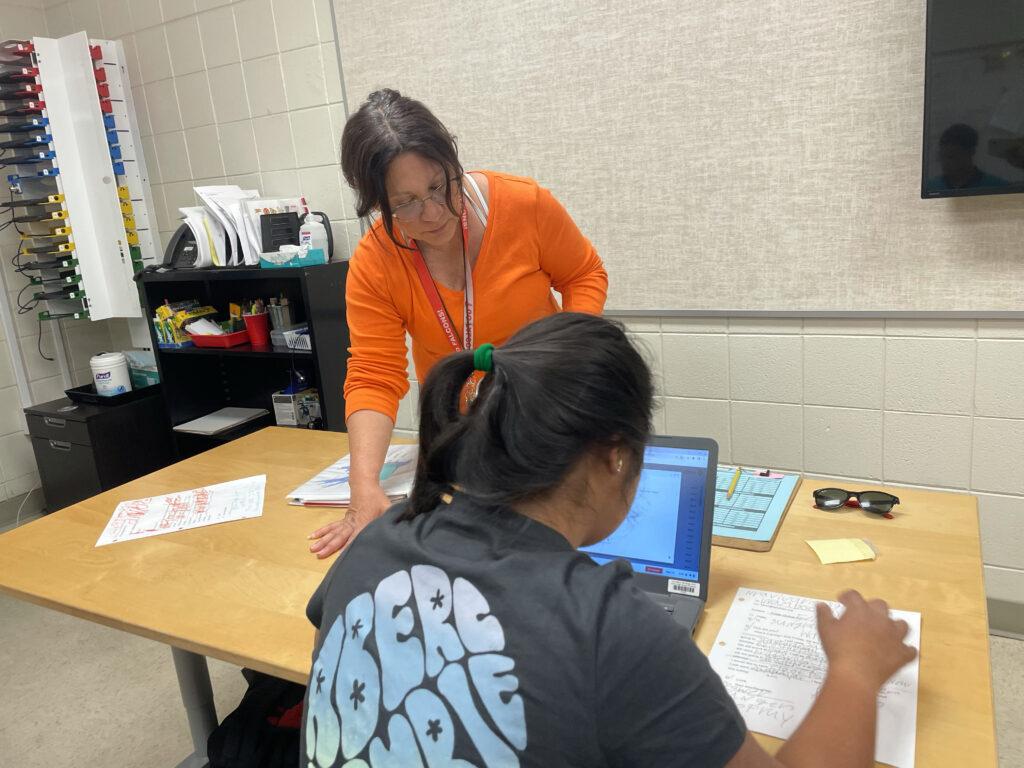Special education resource aide Kelly Allen’s fondest memories with a student she helps on a one-to-one basis are those in which the student succeeds in her daily endeavors. Allen says that seeing her and the other staff members’ efforts pay off in a positive way — whether it be overcoming everyday challenges or implementing new techniques to help students throughout their day — is the most fulfilling part of her job.
“For me personally, learning the psychology of how to support another person is very rewarding,” Allen said. “I got to know her parents as well and build their trust — so it feels like an extended family situation. You’re so invested in this one person and everything that goes into their life.”
Allen has been in the department since 2020, working alongside a current network of 19 aides that span across three programs grouped under the umbrella term special education. The aides not only support students with disabilities, but also those who experience difficulties working in mainstream classrooms.
The first of the three special education programs is Community Based Instruction (CBI), which serves students with increased support needs through specialized classes, mainstream electives and community-based instruction. The school’s Specialized Academic Instruction (SAI) program is designed to support mainstream students in general education classes, while also following their Individual Education Plan. The third offshoot, the Achieving Student Success with Intervention Support and Therapy (ASSIST) program, serves students who have suffered mental health struggles or trauma, offering therapy to help them make emotional and academic progress.
Aides are divided across the programs based on demand, availability and class to support a large number of students with individual needs. While the ASSIST program has one aide, Trisha Lee, for its 15 students, CBI has about 12 one-to-one and district aides for its 30 students. Likewise, the SAI program has four aides to help its 120 students.
These aides include Steve Matos, Richard Racz, Janeka White, Sahar Binesh, Terry Douglass, Sydney Zepeda, Kasey Felix, Corina Campa, Ayesha Bhatti, Kelly Allen, Tamara Coe, Ken Koop, Sahar Binesh, Kasey Felix, Cynthia Chen, Grace Conely and Raquel Kirby. However, special education department chair Brian Elliott emphasizes that some aides can switch between programs based on student need.
“The thing about this department is that it’s a constant moving target,” he said. “However we can best serve students is how we try to define the aide allocation, and those individual student needs can change constantly.”
Though some aides work one on one with students and others are assigned to support classroom settings and case managers, or home-room teachers, all aides have a common goal — supporting students in their instructional classes.
In many cases, these positions are part-time and always lower paying than teaching and other certificated positions, which require both a college degree and credentialing in subject areas such as math, science, or English. The lower wages for aides often pose an issue when trying to attract people to the job. This hiring difficulty has been exacerbated in recent years due to the pandemic, Elliott said.
“The amount of aide positions that need to be filled fluctuates each day […] about four to five are needed on days when a few people call in sick,” he said. “There have also been aides that have left in the middle of their term, so while the department fills in those positions we could have a shortage of one or two.”
Currently, the department is fully staffed, but a few times a year the department suffers shortages that are hard to fill.
Douglass, a CBI general aide, observed the increasing need for special education aides while she was hired as a TPP-Job Coach, in which she found jobs for special education students for them to get real-life experience. After working as a substitute aide, she decided to switch jobs permanently. Douglass believes that the main reason for the aide shortage is the demanding nature of the job.
“[It causes] burn-out quickly and nothing can prepare you for what can happen, but it’s also a rewarding position when all goes right,” Douglass said. “Unfortunately, we live in a very expensive area and the pay is not equivalent to the work compared to other jobs.”
The difficulty in hiring and retaining aides can result in reshuffling remaining aides to the areas of greatest need, sometimes leaving the highest functioning students without the same level of support for a short period.
To help retain good aides, the district is offering more responsibilities to remaining part-time aides to help them achieve fuller working weeks. For example, a member of staff could work as an aide for six hours a day, but drive students across campus in the morning or afternoon. In doing so, they would earn full-time a salary while still receiving benefits.
Though the school isn’t always able to hire all the aides it needs at a given time, those who continue to work in the program put in a tremendous amount of effort to provide individualized and group services. Douglass advocates for its ability to create irreplaceable bonds between them and their students, though the job may come with its share of challenges.
“It is emotionally and physically draining at times, it’s not easy or for the weak hearted,” Douglass said. “We are here to service the students, instill trust, security, confidence, and help improve their lives all while trying to educate. It is a dance we all have to do, but these kids have a harder task at hand in order to be successful. I do think the students and staff are very lucky to have each other; it’s a special group.”




























